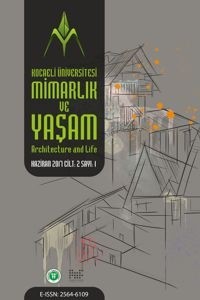Heterotopik Bir Mekân: Tophane-i Amire Kültür Ve Sanat Merkezi
Çalışma hazırlanırken nitel araştırma yöntemlerinden genel tarama modeli kullanılarak tespit yapılmak istenmiştir. Michel Foucault’un mekân ve heterotopya hakkındaki metinleri taranmıştır. Ardından Tophane-i Amire’nin tarihine dair yazılı metinler incelenmiştir. Araştırma nesnesi olarak seçilen mekânın ‘heterotopik’ değerlendirimesi ve kavramın somut bir örnekle incelenmesi amaçlanmıştır. Bu çalışmada önemli bir tarihe sahip, çeşitli medeniyetlere ev sahipliği yapmış ve pek çok tarihi yapıyı bulunduran İstanbul şehrinde, heterotopya kavramına karşılık gelebilecek yapılar olduğu düşünülmüştür. Bu doğrultuda Tophane semtinde yer alan Tophane-i Amire Kültür ve Sanat Merkezi heterotopik mekân olarak incelenmiştir. 20.yy filozoflarından Michel Foucault’un mekân hakkında yaptığı çalışmalar genelde kurum binaları üzerinde yoğunlaşmıştır. Bunun yanında kavramsal mekânla ilgili ‘heterotopya kavramı’nı geliştirmiştir. Heterotopik mekânların kullanıcı üzerindeki etkisinin yanında kentsel tasarımların ve yapıların heterotopya kavramıyla olan denkliği de araştırmalara konu olmuştur. Mimari yapılar, senelerce ayakta kalmış, farklı dönemlere şahitlik etmiş olup, yapının formu ve konumu doğrultusunda farklı kullanımlar için yeniden işlevlendirilebilirler. Bu yapılar, önceki işlevinin yeni mekân organizasyonunu olumsuz etkilememesi gözetilerek tasarlanırken, önceki işlevine dair göstergeleri ve o döneme ait hissiyatı kullanıcılarına aktarır. Bazı yapılar ise yeni ve eski işlevini aynı anda kullanıcıya hissettirebilir. Böylece mekân kullanıcıda parçalı olarak algılanırken bütünlüğün tamamen ortadan kalkmadığı, heterojen olduğu görülür. Kullanıcısına ‘öteki mekân’ deneyimi yaşatarak, Foucault’un ifadesiyle ‘ayna’ görevi görürler.
Anahtar Kelimeler:
Michel Foucoult, Heterotopya, Tophane-i Amire, Heterojen Mekân
A Heterotopic Place: Tophane-i Amire Culture and Art Center
Architectural structures have survived for years, witnessed different periods and can be re-functionalized for different uses according to the form and location of the building. These structures are designed by taking into consideration that the previous function does not adversely affect the new space organization, and it transmits the indicators of the previous function and the feeling of that period to its users. Some structures can make the user feel new and old at the same time. In this way, the user detects the space in a fragmented manner, but the integrity is not eliminated and is heterogeneous. It serve as ‘mirror’ with Foucault's expression, giving the user experience of ‘other space’. Michel Foucault, one of the 20th century philosophers, focuses on the premises of the institution. Besides, he developed the concept of heterotopia about conceptual space. Similar to the effect of heterotopic spaces on the user, the equivalence of urban designs and structures with the concept of heterotopia has been the subject of research. In this study, the city of Istanbul, which has an important history, hosted several civilizations and had many historical buildings, was thought to be the structures that conform to the concept of heterotopia. The Tophane-i Amire Culture and Art Center in the Tophane district has been investigated as a heterotopic space. While preparing the study, it was aimed to determine the qualitative research methods by using the general screening model. Michel Foucault's texts on space and heterotopia were scanned. Then, written texts about the history of Tophane-i Amire were examined. The aim of this study is to evaluate heterotopically the selected space as research object and to examine the concept with a concrete example.
Keywords:
Heterotopia, Tophane-i Amire, Michel Foucoult, Heterogeneous space,
___
- Michel Foucault
- Gaston Bachelard
- Henri Lefebvre
- Senem KAYMAZ KOCA, Jonathan HALE
- Salim Aydüz
- ŞAFAK TUNÇ
- Stuart Elden
- Tolga Yalur
- LEVENT ŞENTÜRK
- Hasan Ünal Nalbantoğlu
- Gülsün Nakıboğlu
- MUSTAFA GİRGİN - MUSTAFA ERTÜRK - İLKER AYSEL - BAYRAM AKÇA
- Gülin DEDE
- ISSN: 2564-6109
- Başlangıç: 2016
- Yayıncı: Kocaeli Üniversitesi
Sayıdaki Diğer Makaleler
Gözün Görme İşlevi ve Sanal İç Mimari Ürün
Burcu YILDIRIM, Deniz DEMİRARSLAN
16. Yüzyıl Eyüp Mescitlerinin Koruma Sorunları
Türkiye'deki Mimari Teknoloji Eğitimine Yönelik Bir Analiz
Hülya Nur KIZILYAPRAK, M. Cem ALTUN
Heterotopik Bir Mekân: Tophane-i Amire Kültür Ve Sanat Merkezi
Pinar TUĞCU, Tülin VURAL ARSLAN
Ofis Tasarımında Ergonomik ve Antropometrik Etkenler
Binalarda Enerji Verimliliği Kapsamında Yapılan Projelerin Değerlendirilmesi: Türkiye Örneği
Kent Dokusu Morfolojik Değişiminin Fraktal Geometri Aracılığıyla Hesaplanması: Bursa Örneği
